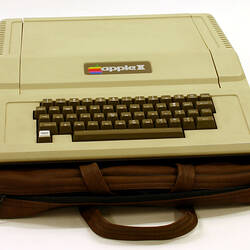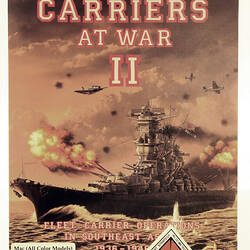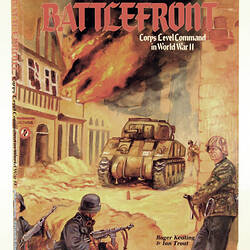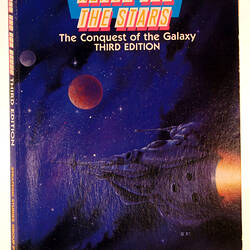Summary
'Carriers At War 1941-1945: Fleet Carrier Operations in the Pacific' is a computer game on one 5¼ inch floppy disk in a cardboard folder with two booklets and 3 large instruction cards.
'Carriers At War 1941-1945' was introduced in 1984.
This is one of a series of games in which software micromanaged the actions of the individual units, for example ships and squadrons of planes.
The series used the same format but different battle scenarios in the Pacific Theatre of World War II. The Macintosh had Volumes 1 and 2, while there was only one version for the Apple II. The Macintosh allowed mouse control and had higher definition graphics. The Apple II version used keyboard control.
The setting is the Pacific campaign in World War II. There were several scenarios. A campaign editor, which was sold separately, allowed users to create their own scenarios, as many as they liked. The one player was the task force commander and the player could play either side. The commander gave general orders to ships and squadrons. The software would then micromanage the orders. The game had a sound capability that was determined by the limitations of the hardware.
This software was collected because it was designed and produced in Australia, developed by the Strategic Studies Group, commonly known as SSG.
The game was also collected because it is representative of games developed for the Apple II series of computers.
In 1983, the donor's parents gave him an Apple II Europlus. He used it for essays, medical school assignments and games. He became especially interested in war games and he stated that an Australian Sydney-based company Strategic Studies Group had the best war games at that time, which he began and continued to collect.
Part of a representative collection of hardware, software, trade literature and promotional material that documents the history of the Apple company, and its contribution to, and impact on the computer industry and society.
Physical Description
The object is a 3 fold cardboard cover, printed in colour with a slot for a floppy disk. The manuals and cards are inserted inside the folded cover . The disk is a 5 1/4 inch floppy disk and the Player's manual is a booklet of 15 pages and a "Design Manual" of 24 pages. The three yellow cards are printed with battle maps and game menus.
More Information
-
Collection Names
The Apple Company Collection, Internet Macintosh User Group (iMug) Collection
-
Collecting Areas
-
Acquisition Information
Donation from Chee-Yan Hiew, 22 Nov 2006
-
Manufacturer
Strategic Studies Group, Sydney, Greater Sydney, New South Wales, Australia, 1984
Strategic studies group has been making computer games since 1983. -
Format
Magnetic carrier, Floppy disk, 5¼ inch
-
Inscriptions
On the cover are the words "Carriers at War 1941 - 1945 Fleet carrier operations in the Pacific" - by Roger Keating and Ian Trout" with three stickers 1: "Apple IIe IIc" 2: " Diskette" 3: Free program voucher Details inside" The rear of the folder includes the text: "A game for the Apple II family 64 k Disk Apple is a registered TM of Apple Computer Inc." " Distributed by OZI Soft " Made in Austalia Floppy Disk Label: "Carriers at War Master Disk " Apple II Family 64 k ©SSG 1984 All Rights Reserved Booklet 1 :"Carriers at War Player Manual " Booklet 2: "Carriers at War Design Manual" Card 1: "Carriers at War battle Map A", on reverse Battle Map B Card 2: "Carriers at War Battle Map C ", on reverse " Design Map" Card 3: " Carriers at War - Game Menus , on reverse stating instructions. A set five Sticky backed back up labels. A software questionnaire mail out registration card.
-
Brand Names
-
Classification
-
Category
-
Discipline
-
Type of item
-
Overall Dimensions
290 mm (Length), 225 mm (Width), 10 mm (Height)
Approximate case dimensions.
-
References
[Link 1] (accessed 13 August 2008)
-
Keywords
Computer Games, Computer Software, Computers, Computing, Education, Entertainment, World War II, 1939-1945




